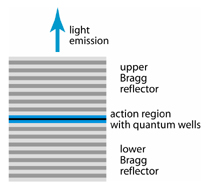Optipedia • SPIE Press books opened for your reference.
Vertical-Cavity Surface-Emitting Lasers
Excerpt from Field Guide to Lasers
A vertical-cavity surface-emitting laser (VCSEL) emits light that is perpendicular to the semiconductor wafer surface. The laser resonator consists of a thin active region with one or several very thin (quantum well) amplifying layers sandwiched between two distributed Bragg reflectors (DBRs), where one has a very high reflectivity and the other (the output coupler) has a slightly lower reflectivity of ≈99%.  For example, electrical pumping is possible by making the DBRs from doped (electrically conducting) material and connecting them to metallic electrodes, where the top electrode has a ring form to couple out the light. A low pump threshold can be achieved with additional structures for confining the electrical current to a small area. Thousands of such VCSEL chips can be fabricated on a single wafer, and they may be packaged separately or as laser arrays.
For example, electrical pumping is possible by making the DBRs from doped (electrically conducting) material and connecting them to metallic electrodes, where the top electrode has a ring form to couple out the light. A low pump threshold can be achieved with additional structures for confining the electrical current to a small area. Thousands of such VCSEL chips can be fabricated on a single wafer, and they may be packaged separately or as laser arrays.
A typical VCSEL emits a few milliwatts of output power in a circular, moderately divergent, and nearly diffraction-limited beam, which is easier to collimate (or couple into a single-mode fiber) than the output of an edge-emitting laser. Output wavelengths can vary from between 650 nm and 1300 nm for GaAs-based VCSELs or 1300 nm to 2000 nm using InP. The optical spectrum is narrow due to emission on a single resonator mode, and the output can be rapidly modulated (e.g., for data transmission with 10 Gbit/s). The active area and thus the output power are limited by the difficulty of achieving single transverse mode operation with a very short laser resonator and homogeneously pumping a large area with a ring electrode.
R. Paschotta, Field Guide to Lasers, SPIE Press, Bellingham, WA (2008).
View SPIE terms of use.

